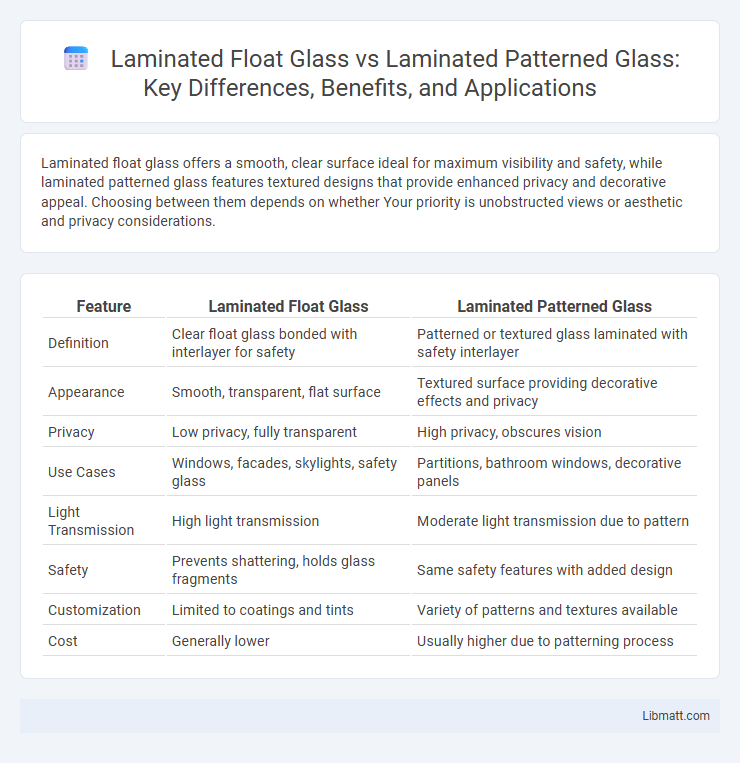Laminated float glass offers a smooth, clear surface ideal for maximum visibility and safety, while laminated patterned glass features textured designs that provide enhanced privacy and decorative appeal. Choosing between them depends on whether Your priority is unobstructed views or aesthetic and privacy considerations.
Table of Comparison
| Feature | Laminated Float Glass | Laminated Patterned Glass |
|---|---|---|
| Definition | Clear float glass bonded with interlayer for safety | Patterned or textured glass laminated with safety interlayer |
| Appearance | Smooth, transparent, flat surface | Textured surface providing decorative effects and privacy |
| Privacy | Low privacy, fully transparent | High privacy, obscures vision |
| Use Cases | Windows, facades, skylights, safety glass | Partitions, bathroom windows, decorative panels |
| Light Transmission | High light transmission | Moderate light transmission due to pattern |
| Safety | Prevents shattering, holds glass fragments | Same safety features with added design |
| Customization | Limited to coatings and tints | Variety of patterns and textures available |
| Cost | Generally lower | Usually higher due to patterning process |
Introduction to Laminated Float Glass and Laminated Patterned Glass
Laminated float glass consists of two or more layers of float glass bonded with an interlayer, providing enhanced safety, sound insulation, and UV protection. Laminated patterned glass incorporates textured or patterned surfaces within the laminated structure, combining the benefits of laminated safety glass with decorative and privacy features. Both types offer durability and aesthetic versatility, suitable for architectural, automotive, and interior applications.
Composition and Manufacturing Processes
Laminated float glass consists of two or more layers of clear float glass bonded with a polyvinyl butyral (PVB) interlayer, manufactured through a process of cleaning, assembly, and autoclaving to ensure safety and durability. Laminated patterned glass follows a similar lamination process but incorporates textured or patterned float glass sheets, created by passing molten glass over patterned rollers or embossing tools before lamination. The key difference lies in the surface design and manufacturing stage before lamination, where patterned glass adds aesthetic or privacy features without compromising the structural benefits of the laminated assembly.
Key Differences in Appearance and Texture
Laminated float glass offers a smooth, clear surface with minimal distortion, allowing maximum light transmission and visibility, making it ideal for sleek, modern designs. Laminated patterned glass features embossed or textured patterns within the laminated layers, providing decorative effects and enhanced privacy by diffusing light and obscuring views. The key difference lies in laminated float glass's clarity and flatness versus the textured, ornamental surface of laminated patterned glass, which influences both aesthetics and functional applications.
Strength and Safety Comparison
Laminated float glass offers superior strength due to its smooth surface and uniform thickness, providing reliable impact resistance and enhanced safety in architectural applications. Laminated patterned glass, while still strong, incorporates textured designs that may slightly reduce its overall structural integrity but improve privacy and aesthetic appeal. For your projects requiring maximum durability and safety, laminated float glass is the preferred choice, especially in areas prone to high impact or where clear visibility is essential.
Privacy and Light Diffusion Considerations
Laminated float glass offers clear visibility with enhanced safety, while laminated patterned glass integrates textured designs that increase privacy by obscuring direct sightlines. Patterned glass diffuses light more effectively, creating softer illumination and reducing glare compared to the transparent nature of float glass. For spaces requiring both protection and controlled light diffusion, laminated patterned glass serves as an optimal solution balancing visibility and privacy.
Acoustic Insulation Capabilities
Laminated float glass offers superior acoustic insulation by incorporating a PVB (polyvinyl butyral) interlayer that effectively dampens sound vibrations, making it ideal for reducing external noise in residential and commercial settings. Laminated patterned glass, while also featuring a PVB layer, has textured surfaces that can slightly modify sound transmission but generally provide less acoustic insulation compared to smooth laminated float glass. Your choice between these materials should consider the specific noise reduction requirements of your environment to maximize comfort and privacy.
Energy Efficiency and UV Protection
Laminated float glass offers superior energy efficiency by providing excellent thermal insulation and reducing heat transfer, which lowers cooling and heating costs in buildings. It also provides high UV protection by blocking up to 99% of harmful ultraviolet rays, preventing interior fading and skin damage. Laminated patterned glass, while offering comparable UV protection, usually has slightly lower energy efficiency due to its textured surface that can affect solar heat gain and light transmission.
Common Applications in Architecture and Design
Laminated float glass is widely used in architectural applications requiring safety and sound reduction, such as facades, windows, and skylights, due to its clarity and strength. Laminated patterned glass offers both safety and aesthetic appeal, often utilized in interior partitions, decorative panels, and privacy screens where textured surfaces enhance design elements. Your choice between these types depends on whether you prioritize transparency and protection or decorative texture and privacy in your project.
Cost and Maintenance Factors
Laminated float glass generally costs less than laminated patterned glass due to simpler manufacturing processes and fewer decorative elements. Maintenance for laminated float glass involves straightforward cleaning with standard glass cleaners, while patterned glass may require gentler care to preserve textures and prevent damage to the surface design. Your choice between these options should consider long-term upkeep expenses alongside initial installation costs.
Choosing the Right Glass for Your Project
Laminated float glass offers a smooth, clear surface ideal for projects requiring maximum transparency and UV protection, while laminated patterned glass incorporates textured designs to enhance privacy and aesthetic appeal. Your choice depends on whether clarity or decorative privacy better suits your project's functional and stylistic needs. Consider factors like light transmission, safety requirements, and design goals to select the most effective laminated glass type for your installation.
Laminated float glass vs laminated patterned glass Infographic

 libmatt.com
libmatt.com